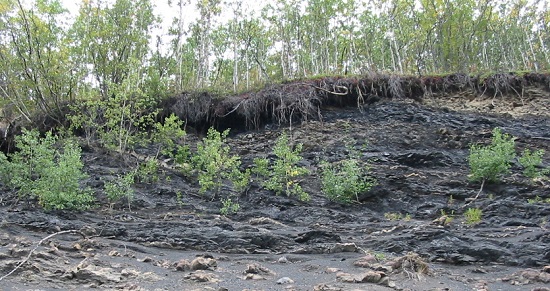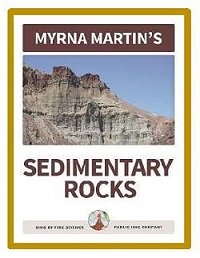Coal Formation began in ancient swamps
swampy areas in tropical climates
Carboniferous period of Earth’s history
Coal formation begins in swampy areas in warm
tropical climates. The tropical swamp forests developed in the Carboniferous
period of Earth’s history. The coal swamp forests contained seedless vascular
plants that existed in forests of Europe and North America. These seedless
vascular plants provided the plant debris that became coal.
Sedimentary layers in ancient swamps
Ancient swamps
Leaves and other debris of plants living in swamp forests
fell into the swamp where layer upon layer of plant material collected. Even
trees after they died and fell into the swampy water added to the layers of
plant material in the swamp.
Standing water
The coal swamp forests that produced coal all contained
standing water. The standing water did not have enough oxygen for the plants to
decay. Normally insects and other organisms would have lived in the swampy
waters and eaten much of the plant debris. The lack of oxygen prevented insects
and other organisms from living in the water.

Coal layers exposed in a roadside cut in Alaska
accumulation of plant debris in swamps
Thick layers of plant debris
Plant debris collects very slowly. The plant debris
collecting in the swamps must be greater than the rate the plant debris decays.
As the plant debris is increasing in size it is covered in silt and sand when
flood waters cover the area.
A coal seam that is two meters thick requires plant debris that is twenty meters deep to compress and lithify into coal. This takes thousands of years to accumulate in a swamp.
Two ways plant debris collects in swamps
There are
two ways that this amount of plant debris can collect in a swamp.
1.
The waters rise at the same rate as the plant
material collects on the floor of the swamp.
2.
The land in the swamp is subsiding at the same
rate the plant debris is accumulating.


Click for More Information and to Order
Peat
What is peat
Peat is principally bog plants including mosses, sedges, and
shrubs. Peat forms when plant material does not fully decay in waters that are
acidic and lack enough oxygen for the plants to decay. Peat is partly
decomposed vegetation showing a wide range of decomposition.
Stage in the formation of coal
Peat is the first stage in the formation of coal. It is
a brown to black accumulation of woody plant material. It has a moisture
content about 75%. After the peat is dried, it burns freely.
lignite coal
Rank of lignite coal
Lignite is the lowest rank of true coal. It is generally
yellow to dark brown. It formed in areas at shallow depths and temperatures
less than 100°
C. It lacks luster and often displays the original wood structure. Lignite
burns readily with a smoky flame. It has a strong odor as it burns. Lignite
contains as much as 40% moisture and crumbles upon exposure to the atmosphere.
The content of lignite is between 35% and 45% carbon.
Uses of lignite coal
Many thick layers of lignite coal lie close to the
surface of the Earth. The layers of coal are sometimes more than 30 meters
thick. Most lignite is used to generate electricity. In areas where other fuels
are scarce, the production of brown coal far exceeds that of bituminous coal.
Bituminous coal
Sub-bituminous coal
Sub-bituminous
coal contains more moisture and less sulfur than other types of bituminous
coal. There are three ranks of sub-bituminous coal a, b, and c.
Characteristics of bituminous coal
Bituminous coal is black and has a glassy or pitchy
luster with distinct bands or layers and no evidence of a wood structure.
Bituminous coal does not crumble upon exposure to air. It is widely used to
generate electricity and make coke for the steel industry.
Rank of Bituminous Coal
Bituminous coal is intermediate in rank. It is sometimes
called soft coal. Bituminous coal is the most abundant kind of coal. It has a
high heating value and a high sulfur content. More than 80% of the coal burned
in the U. S. is bituminous coal. It is used in the production of electricity.
Uses of bituminous coal
Many different chemicals are by products of bituminous
coal. These chemicals are used to make paint, nylon, aspirin, and many other
items.
Anthracite Coal
Rank of anthracite coal
Anthracite
is the highest rank of coal. It has the highest heating value and the highest
carbon content. Anthracite coal is very hard, deep black, and looks almost
metallic because of it is brilliantly glossy appearance.
Uses of anthracite coal
The primary market for anthracite coal is heating homes
because it burns longer, with little smoke or odor. The only drawback is that
anthracite coal is more difficult to ignite than other coals.
Coal is a Non-renewable energy resource
Coal is a non-renewable energy source because of the long period of time it takes to form deep layers of plant material. The plants that created the coal we are using today were giant plants that lived millions of years ago in swamp forests.
The
giant plants and ferns living in the prehistoric swamp forests produced vegetable matter
that formed deep layers of vegetable debris. The length of time it took to
form these deep layers of vegetable matter in swamps means that all the coal we
will ever have to use here on Earth has already been created.
KIDS FUN Science Bookstore
Check out Myrna Martin's award winning textbooks, e-books, videos and rock sets. The Kids Fun Science Bookstore covers a wide range of earth science topics. Click here to browse.










